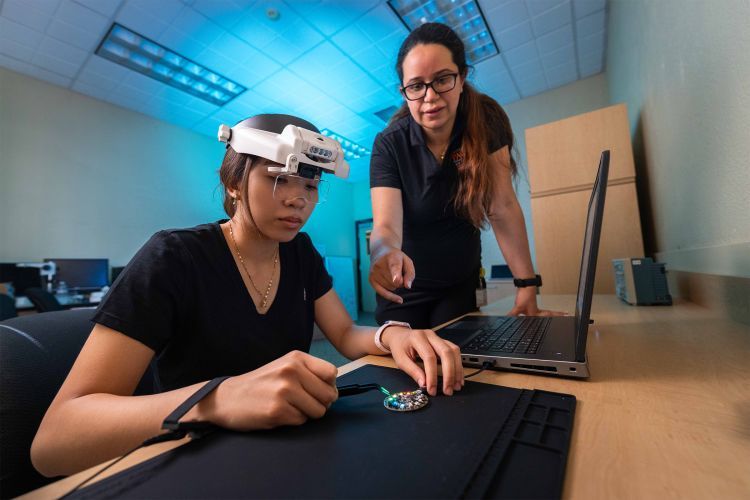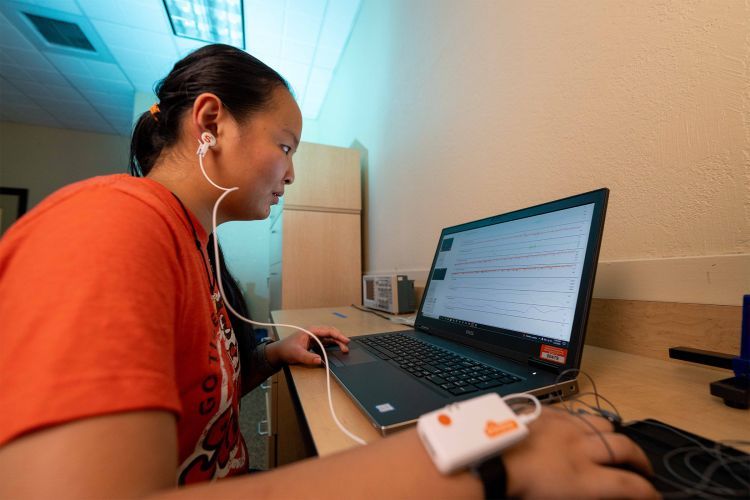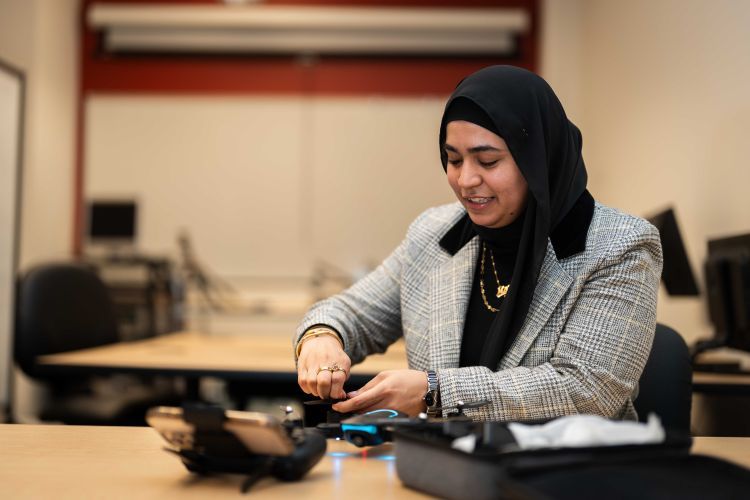Breadcrumb
Engineering professor developing device to diagnose autism at earlier age

Kyra-Angela Magsayo works on a micro controller unit with guidance from Assistant Professor Seyedeh Fatemeh Khatami Firoozabadi.
An assistant professor of engineering at University of the Pacific plans to develop a device to help diagnose autism at an early age with the aid of a prestigious National Science Foundation grant.
Seyedeh Fatemeh Khatami Firoozabadi is the lead investigator for the two-year, $200,000 grant which she believes will “fill a significant gap” that now exists.
“One in 36 children is diagnosed with autism, but there really is little technology to help in early diagnosis,” Firoozabadi said. “There also is a gap between when symptoms occur (often by age 1) and when doctors diagnose them (some children are not diagnosed until age 4). We plan to address that.”
Autism, or autism spectrum disorder, refers to a broad range of conditions characterized by challenges with social skills, repetitive behaviors, speech and nonverbal communication.
Her research team works to develop a wearable device using different types of sensors and an MCU—micro controller unit—to collect data from young participants.
“With this research, we hope to successfully create a wearable device—either a wristband or a clip-on likely—and make it small so it does not detract attention from young children during the experiment,” Firoozabadi said. “This research study is aiming to analyze the data from the wearable sensor to monitor environmental conditions such as lighting, sounds and young children's responses, which can be key factors in detecting autism. We plan to build the device so it will detect and study those indicators.”
The hope, she said, is for the research and development to be successful so that it attracts additional funders and serves more children.
Firoozabadi began preliminary work May 15 and will collaborate with a faculty member, two undergraduate students and one graduate student each year.
Students Kyra-Angela Magsayo ’25 and Crystal Zhu ’25 said they are gaining valuable experience working on the project.
“I was interested in getting involved in research, and this was a perfect opportunity on an interesting subject,” said Magsayo, a bioengineering major and Powell Scholar. “The combination of studying autism with engineering principles is rewarding.”

Bioengineering and applied mathematics major Crystal Zhu is one of three students collaborating with Khatami Firoozabadi on the research.
Added Zhu, a double major in bioengineering and applied mathematics: “Because of this work, I now plan to look at areas involving research when I work on my master’s degree.”
The grant could have residual impacts for Pacific, said Provost and Executive Vice President for Academic Affairs Gretchen Edwalds-Gilbert.
“The National Science Foundation funds basic scientific research through a competitive peer review process. The award is prestigious for Pacific and helps pave the way for other faculty to apply for and receive external research funding,” she said.
“In addition, Professor Firoozabadi included support for undergraduate and graduate research students in her grant, providing hands-on mentored research experiences for students. These experiences are critical to student success and retention and for job and graduate school placement after Pacific.”
The work will follow the multi-departmental approach President Christopher Callahan has urged faculty to pursue. Madhu Sundarrajan, an assistant professor of speech-language pathology, will coach Firoozabadi on her interaction with children being studied.
Elizabeth Orwin, dean of the School of Engineering and Computer Science, said Firoozabadi, who joined Pacific in 2019, “does interesting work in multiple spaces. She also has used sensors and other equipment to measure signals in the body. This is a big step for her to receive her first NSF grant.”





